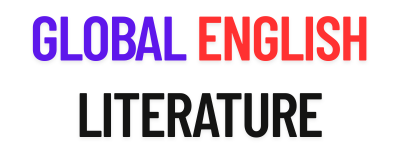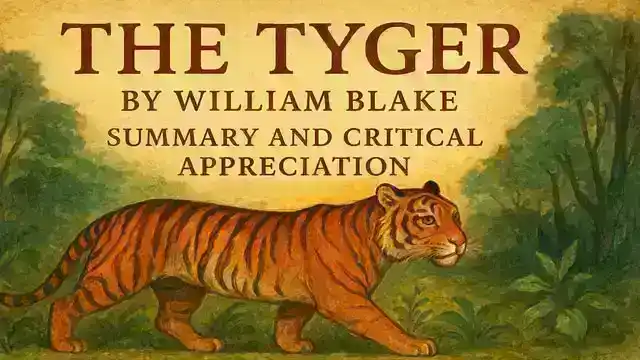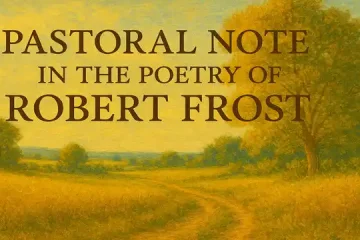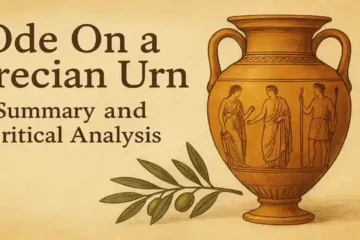Introduction of “The Tyger”:
William Blake’s “The Tyger” is best understood in contrast with his companion poem “The Lamb.” While the lamb represents innocence, gentleness, and the beauty of God in His tender aspect, the tiger embodies a more complex and awe-inspiring vision of divinity. After enduring the sorrows and disappointments of life, humanity often seeks to understand God not only as a source of comfort but also as a force of power, restlessness, and fierce beauty. Many scholars regard “The Tyger” as Blake’s most famous and striking poem.
In this work, the image of the tiger symbolizes divine energy burning brightly amid a world darkened by sin and corruption— “the forest of the night.” God, therefore, is not limited to the meekness of the lamb but also reveals Himself in the terrifying majesty of the tiger. To the innocent, He appears as gentle and kind; to the sinful, He is fearsome and unyielding. Blake describes the tiger’s fiery eyes, its powerful leaps, and its fearful symmetry with a sense of awe and wonder. The poet questions what kind of Creator could fashion such dreadful yet beautiful limbs and whether He felt pride in this creation. Ultimately, Blake marvels at the paradox that the same God who made the mild lamb is also the maker of the fierce and violent tiger.
Summary of the Poem “The Tyger”:
The Tiger as Divine Power in a Dark World:
In utter darkness the tiger is shining bright in the forest. The forest symbolizes the world which is dark under the influence of sin, corruption and ignorance. The tiger, is the divine power that appears to show the right path. The fearful symmetry of the tiger’s body suggests that the figure is created by God. There appears a natural question regarding the creation of such a violent animal by the merciful Almighty. In fact the world is made of both elements: the lamb element and the tiger element. God appears as a tiger to sinners and evildoers while for the gentle and innocent, he comes in the mild shape of a lamb.
The Poet’s Wonder at the Tiger’s Perfection:
The poet wonders at the perfection of creation exposed in the figure of the tiger. The uncommon bright of the tyger’s eyes may not be found in any ocean or sky. The poet imagines that an angel should have flown high in the sky to hold this brightness. Now he imagines about building of the tiger’s body. The maker of the violent animal ought to be stronger than a tiger. The poet wonders at the dreadful paws and legs of the tiger. It is a unique blend of horror and beauty created in the body of the tiger.
The Poet’s Questions on the Creation of the Tiger:
The poet wonders at the perfect creation of a tiger and imagines how the Almighty would have created the tiger. What hammer, chain and anvil were used in forming the perfect figure of a tiger. What sort of furnace was used to frame the mighty brain of a tiger whose appearance is so terrible. He thinks after creating such an animal God would have felt pride and looked at his creation with a smile of satisfaction. Just then the poet falls into a complex thinking if the maker of a tiger and a lamb is the same power. In fact God, the Almighty appears in both forms in the world.
Critical Appreciation of the Poem “The Tyger”:
Introduction:
William Blake’s “The Tyger” is one of his most celebrated poems, often read in contrast to his earlier poem The Lamb. While “The Tyger” appears in “Songs of Experience”, “The Lamb” is part of “Songs of Innocence.” Together, they reflect Blake’s vision of the universe as composed of opposing yet complementary forces. As the philosopher Jacob Boehme suggested, creation is shaped by two contrasting elements symbolized by the lamb and the tiger. The lamb, gentle, innocent, and pure, represents God in His state of innocence. In contrast, after enduring the sorrows and hardships of life, humanity seeks to understand God in a fiercer form, embodied by the tiger. Though the tiger is powerful, restless, and fearsome, it is also marked by a striking beauty.
Development of Thought:
It is a short lyric in twenty four lines. The first four lines are repeated in the end. Thus it is a poem in five stanzas of four lines each. The first stanza expresses the poet’s admiration for the tiger.
Tiger! Tiger burning bright
In the forests of the night,
What immortal hand or eye
Dare frame thy fearful symmetry?
In the utter darkness, the tiger is shining bright in the forest. The dark forest is symbol of the world degenerated under the influence of sin, ignorance and corruption. The poet wonders at the fearful symmetry of the tiger’s body.
In what distant deeps or skies
Burnt the fire of thine eyes?
On what wings dare he aspire?
What the hand dare sieze the fire?
And what shoulder, & what art,
Could twist the sinews of thy heart?
And when thy heart began to beat,
What dread hand? & what dread feet?
The poet wonders at the perfection of creation exposed in the figure of the tiger. The poet imagines that an angel should have flown high in the sky to find out the brightness of the tiger’s eyes and perfect mould of body which presents a unique blend of horror and beauty in single figure.
What the hammer? what the chain?
In what furnace was thy brain?
What the anvil? what dread grasp
Dare its deadly terrors clasp;
When the stars threw down their spears,
And water’d heaven with their tears,
Did he smile his work to see?
Did he who made the Lamb make thee?
The poet wonders at the perfect creation of the tiger and wonders how the Almighty would have created the tiger. What hammer, chain and anvil would have been used in forming the perfect body of the tiger? It too surprises the poet that God is the maker of the both a tiger as well as a lamb. The poet repeats the opening lines at the close of the poem to give force to the tiger’s bright appearance.
Tiger! Tiger burning bright
In the forests of the night,
What immortal hand or eye
Dare frame thy fearful symmetry?
Great Idea:
The poem is full of great ideas. The poet admires the perfect symmetry of the tiger’s figure. It is an indirect praise of God’s perfect creation. The poet points out that God is maker of not only the tiger but the lamb also. It is the effect of wide spread sin, ignorance and corruption that the world is turned into a dark forest. God appears in the figure of a bright tiger to terrify the sinful evil doers.
Tiger! Tiger! burning bright
In the forest of the night,
What immortal hand or eye
Could frame the fearful symmetry?
High Imagination:
The whole poem is based on the poet’s high imagination. He imagines how the tiger’s body could have been made.
What the hammer? what the chain?
In what furnace was thy brain?
What the anvil? what dread grasp
Dare its deadly terrors clasp:
Sensuous Word Pictures:
The poem is highly sensuous in treatment. The poet draws sensuous word picture of the tiger.
Tiger! Tiger! burning bright
In the forest of the night,
or
In what distant deeps or skies
Burnt the fire of thine eyes.




